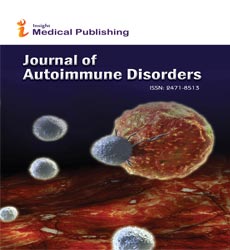Autoimmune Disorders and Aging: Mechanistic Insights and Clinical Challenges
Garcia Chen
Department of Biological Science, Immunology Research Lab, Chosun University, Gwangju, Republic of Korea
Published Date: 2025-02-28DOI10.21767/2471-8513.11.1.115
Corresponding author:
Garcia Chen,
Department of Biological Science, Immunology Research Lab, Chosun University, Gwangju, Republic of Korea,
E-mail: chen.garcia@chosun.kr
Received date: February 01, 2025, Manuscript No. ipado-25-20468; Editor assigned date: February 03, 2025, PreQC No. ipado-25-20468(PQ); Reviewed date: February 15, 2025, QC No. ipado-25-20468; Revised date: February 22, 2025, Manuscript No. ipado-25-20468(R); Published date: February 28, 2025, DOI: 10.21767/2471-8513.11.1.115
Citation: Chen G (2025) Autoimmune Disorders and Aging: Mechanistic Insights and Clinical Challenges. J Autoimmune Disord Vol.11.No.1: 115.
Introduction
Aging is accompanied by profound changes in the immune system, collectively referred to as immunosenescence. This process involves a decline in immune defense against pathogens, impaired vaccine responses, and altered regulation of immune tolerance. Paradoxically, while immune function weakens with age, the prevalence of autoimmune disorders also increases in older populations. Diseases such as rheumatoid arthritis, systemic lupus erythematosus, and autoimmune thyroid disorders often present or worsen with aging, suggesting a complex interplay between immune system decline, chronic inflammation, and loss of self-tolerance. Understanding the mechanistic links between aging and autoimmunity is critical for addressing the unique diagnostic and therapeutic challenges faced by elderly patients [1].
Description
The relationship between aging and autoimmune disorders is largely shaped by immune dysregulation. One key mechanism is the progressive decline of regulatory T cells (Tregs) and thymic output of naïve T cells. With thymic involution, fewer new T cells are produced, leading to an immune repertoire dominated by memory T cells. This imbalance increases the risk of autoreactive lymphocytes persisting in circulation. Additionally, defective clearance of apoptotic cells, a process that becomes less efficient with aging, exposes intracellular autoantigens to the immune system, triggering chronic autoreactivity [3].
Another important factor is inflammaging, a state of low-grade, chronic inflammation characteristic of older individuals. Driven by increased production of pro-inflammatory cytokines such as IL-6, TNF-ñ, and IL-1ò, inflammaging creates a pro-autoimmune environment. This persistent inflammatory milieu not only accelerates tissue damage but also enhances antigen presentation and activation of autoreactive T and B cells. Furthermore, cellular senescence contributes to autoimmunity by secreting pro-inflammatory mediators collectively known as the Senescence-Associated Secretory phenotype (SASP), further fueling immune dysregulation [3,4].
From a clinical perspective, autoimmune disorders in aging populations present unique diagnostic and therapeutic challenges. Symptoms of autoimmunity such as fatigue, joint pain, or cognitive decline often overlap with age-related conditions, leading to underdiagnosis or misdiagnosis. Moreover, older patients frequently have comorbidities and are more vulnerable to adverse drug effects, complicating the use of immunosuppressants or biologics. While targeted therapies such as cytokine inhibitors and immune checkpoint modulators show promise, their use in elderly patients requires careful balance between efficacy and infection risk. Personalized approaches that consider both immune aging and comorbid conditions are therefore essential [5].
Conclusion
The intersection of autoimmune disorders and aging reveals a paradox where immunosenescence coexists with increased autoimmunity. Mechanistic insights point to thymic involution, impaired immune tolerance, inflammaging, and cellular senescence as central drivers of this phenomenon. Clinically, managing autoimmune diseases in older populations is particularly challenging due to overlapping symptoms, comorbidities, and heightened treatment risks. Future strategies should focus on early detection, safer immunomodulatory therapies, and interventions targeting inflammaging to restore immune balance. As research advances, integrating geriatric and immunological perspectives will be critical for improving outcomes and quality of life for elderly patients living with autoimmune-disorders.
Acknowledgment
None.
Conflict of Interest
None.
References
- Alonso-Magdalena L, i Codina OC, Zia E, Sundström P, Pessah-Rasmussen H (2024). Prevalence and disease disability in immigrants with multiple sclerosis in Malmö, southern Sweden. Clin Neurol Neurosurg 240, 108255.
Google Scholar Cross Ref Indexed at
- Haki M, Al-Biati HA, Al-Tameemi ZS, Ali IS, Al-Hussaniy HA (2024). Review of multiple sclerosis: Epidemiology, etiology, pathophysiology, and treatment. Medicine 103: e37297.
Google Scholar Cross Ref Indexed at
- Liu Z, Liang Q, Ren Y, Guo C, Ge X, et al. (2023). Immunosenescence: molecular mechanisms and diseases. Signal Transduct Target Ther 8: 200.
Google Scholar Cross Ref Indexed at
- Berben L, Floris G, Wildiers H, Hatse S (2021). Cancer and aging: Two tightly interconnected biological processes. Cancers 13: 1400.
Google Scholar Cross Ref Indexed at
- Bocian K, Kiernozek E, Domagaà ?a-Kulawik J, Korczak-Kowalska G, Stelmaszczyk-Emmel A, et al. (2017). Expanding diversity and common goal of regulatory T and B cells. I: Origin, phenotype, mechanisms. Arch Immunol Ther Exp 65: 501-520.
Open Access Journals
- Aquaculture & Veterinary Science
- Chemistry & Chemical Sciences
- Clinical Sciences
- Engineering
- General Science
- Genetics & Molecular Biology
- Health Care & Nursing
- Immunology & Microbiology
- Materials Science
- Mathematics & Physics
- Medical Sciences
- Neurology & Psychiatry
- Oncology & Cancer Science
- Pharmaceutical Sciences
